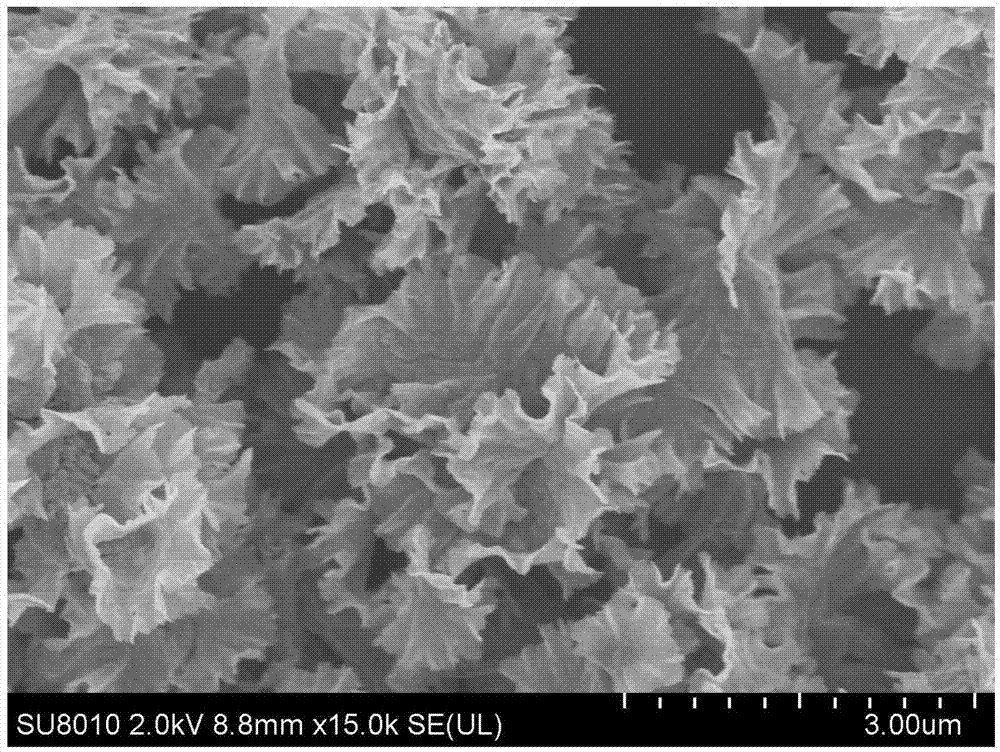Tin bisulfide nanosheet composite material, as well as preparation method and application thereof
A technology of tin disulfide and composite materials, applied in the direction of nanotechnology, nanotechnology, nanotechnology for materials and surface science, etc., can solve the problems of restricting charge and discharge capacity, low conductivity, etc., and achieve easy operation and large surface area , The effect of simple preparation method
- Summary
- Abstract
- Description
- Claims
- Application Information
AI Technical Summary
Problems solved by technology
Method used
Image
Examples
Embodiment 1
[0028] The preparation method of the tin disulfide nanosheet composite material of this example is as follows:
[0029] (1) 20ml 0.04mol / L tin tetrachloride aqueous solution and 20ml 0.16mol / L L-cysteine were mixed together to make a reaction solution, and the reaction solution was transferred to a 50ml polytetrafluoro container , and fix the polytetrafluoroethylene container in a stainless steel reaction kettle, and then use an oven to directly heat it at 200°C for 20 hours. When the temperature of the reaction kettle naturally drops to room temperature, wash the obtained reactants with water and ethanol for 3 times in sequence. The washed sample was dried in an oven at 50° C. for 12 hours to obtain flower-shaped tin disulfide nanosheets; wherein, the concentration of tin tetrachloride in the reaction solution was 0.02 mol / L.
[0030] (2) Then the tin disulfide prepared in step (1) and oleic acid were mixed and ultrasonicated for 1 hour according to the weight ratio of 1:40...
Embodiment 2
[0035] In this example, 20ml of 0.2mol / L tin tetrachloride aqueous solution and 20ml of 0.8mol / L L-cysteine are mixed together to prepare tin disulfide, and the oven is directly heated at 240°C for 20 hours, that is Say, the hydrothermal reaction temperature is 240°C. In step (2), tin disulfide and oleic acid are mixed and ultrasonicated for 1 hour at a weight ratio of 1:60, soaked for 48 hours, and centrifuged to remove excess oleic acid. All the other steps and conditions are the same as in Example 1.
[0036] The composite material prepared in this example was observed with a scanning electron microscope, and the results showed that the size of the amorphous carbon-coated tin disulfide nanosheets in this example was about 3 microns, and the thickness of the nanosheets was about 10 nm. It is measured that in the composite material of this example, the amorphous carbon content accounts for 13.7% of the total weight of the amorphous carbon-coated tin disulfide nanosheet comp...
Embodiment 3
[0039] In this example, 20ml of 0.1mol / L tin tetrachloride aqueous solution and 20ml of 0.4mol / L L-cysteine are mixed together to prepare tin disulfide, and the oven is directly heated at 180°C for 20 hours, that is Say, the hydrothermal reaction temperature is 180°C. In step (2), tin disulfide and oleic acid are mixed and ultrasonicated at a weight ratio of 1:50 for 1 hour, soaked for 36 hours, and centrifuged to remove excess oleic acid. All the other steps and conditions are the same as in Example 1.
[0040] A scanning electron microscope was used to observe the composite material prepared in this example. The results showed that the size of the amorphous carbon-coated tin disulfide nanosheets in this example was about 3.5 microns, and the thickness of the nanosheets was about 10 nanometers. It is measured that in the composite material of this example, the amorphous carbon content accounts for 14% of the total weight of the amorphous carbon-coated tin disulfide nanoshee...
PUM
| Property | Measurement | Unit |
|---|---|---|
| thickness | aaaaa | aaaaa |
| thickness | aaaaa | aaaaa |
| size | aaaaa | aaaaa |
Abstract
Description
Claims
Application Information
 Login to View More
Login to View More - R&D
- Intellectual Property
- Life Sciences
- Materials
- Tech Scout
- Unparalleled Data Quality
- Higher Quality Content
- 60% Fewer Hallucinations
Browse by: Latest US Patents, China's latest patents, Technical Efficacy Thesaurus, Application Domain, Technology Topic, Popular Technical Reports.
© 2025 PatSnap. All rights reserved.Legal|Privacy policy|Modern Slavery Act Transparency Statement|Sitemap|About US| Contact US: help@patsnap.com



